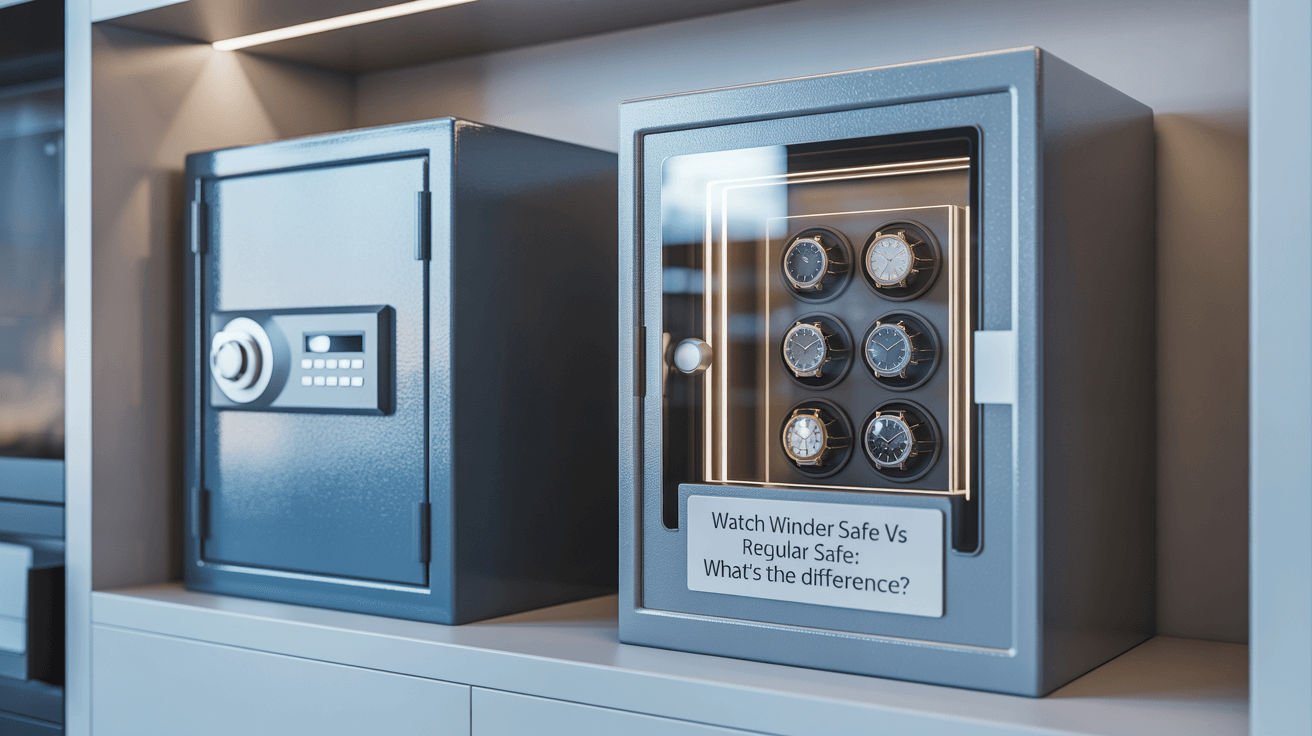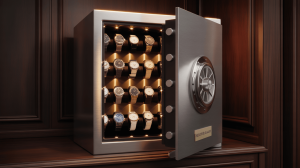Watch Winder Safe vs Regular Safe: What’s the Difference? Here’s the deal… Choosing between a watch winder safe and a regular safe affects how you protect, preserve, and present your collection. Let’s explore the key distinctions.
1. Core Functionality Comparison
A regular safe focuses solely on security—thick steel walls, multi-bolt locking, and fireboard insulation. A watch winder safe adds programmable winding modules, keeping automatics running and accurate.
| Feature | Regular Safe | Watch Winder Safe |
|---|---|---|
| Security | High | High |
| Fire Resistance | Yes | Yes |
| Automatic Winding | No | Yes |
| Climate Control | Optional | Often included |
2. Security and Certification Standards
Both safes can meet UL RSC or ETL burglary ratings and UL 72 Class 350 fire tests. A watch winder safe must maintain these standards even around moving motors, requiring extra reinforcement around winding bays. Regular safes focus all materials on static protection without moving parts.
3. Interior Layout and Organization
Regular safes offer adjustable shelves or foam inserts for mixed valuables. Watch winder safes dedicate specific bays for winders, then static trays for unwound pieces or jewelry. This specialization ensures each automatic stays in its cradle without tangling or contact.
4. Winding Module Capabilities
Only watch winder safes feature TPD (turns-per-day) settings, directional controls (CW, CCW, bi-directional), and pause intervals to match manufacturer specs.
| Capability | Regular Safe | Watch Winder Safe |
|---|---|---|
| Adjustable TPD | N/A | 650–2,000 |
| Directional Control | N/A | CW, CCW, Bi-directional |
| Over-winding Prevention | N/A | Programmable pauses |
5. Climate and Humidity Management
Regular safes may include basic desiccant packs or humidity seals. Premium winder safes often integrate digital hygrometers and active dehumidifiers to maintain 40–50% RH, protecting leather straps and delicate movements more precisely.
6. Noise and Vibration Considerations
Regular safes operate silently except for hinge clicks. Watch winder safes incorporate quiet motors (< 25 dB) and vibration-dampened mounts to avoid disturbing neighboring rooms, combining security with near-silent winding.
7. Smart Features and Connectivity
Advanced watch winder safes offer Bluetooth/Wi-Fi alerts for tampering, low battery, door-open events, and winding status. Regular safes may include basic alarms but rarely remote monitoring.
| Smart Feature | Regular Safe | Watch Winder Safe |
|---|---|---|
| Remote Alerts | Rare | Common |
| App Control | No | Yes |
| Audit Logs | No | Yes |
8. Power and Backup Systems
Regular safes need no power except for electronic locks. Watch winder safes require AC power plus battery backups to run motors through outages. They also include manual override keys or dials to ensure access if electronics fail.
9. Capacity and Expandability
Regular safes scale by size—more interior volume means more watches or valuables in static storage. Winder safes start with fixed winder bays (2–4) but can expand modularly with extra trays, up to 10+ winding slots as needed.
10. Aesthetic and Display Value
Regular safes prioritize concealment and blend into cabinetry. Watch winder safes often feature glass or acrylic display fronts, integrated LED lighting, and premium veneers or leather to showcase the collection as art.
| Design Aspect | Regular Safe | Watch Winder Safe |
|---|---|---|
| Visibility | Hidden | Showcases watches |
| Lighting | External only | Built-in LEDs |
| Finish Options | Standard steel | Veneers, leather, glass |
11. Installation and Anchoring
Both safe types require bolting into studs or concrete. Winder safes need level installation to prevent motor misalignment. Regular safes emphasize secure anchoring; winder safes combine that with vibration-free mounting.
12. Maintenance and Upkeep
Regular safes demand minimal upkeep: dusting, lock tests, and occasional battery changes. Watch winder safes require additional care: motor inspections, winder calibration checks, desiccant pack replacement, and firmware updates for smart units.
13. Cost and Value Analysis
Regular safes range from $100–$1,000 depending on size and ratings. Watch winder safes start around $500 for basic models and exceed $5,000 for luxury smart units. Consider whether automatic winding and display features justify the premium.
| Price Tier | Regular Safe | Watch Winder Safe |
|---|---|---|
| Entry-Level | $100–$300 | $500–$1,000 |
| Mid-Range | $300–$700 | $1,000–$2,500 |
| Premium | $700+ | $2,500+ |
14. Long-Term Preservation
Regular safes protect against theft and fire but leave automatics stationary, risking oil dry-out. Winder safes maintain movement, preserving accuracy and reducing service needs. Over decades, this can save on maintenance costs and extend watch lifespans.
15. Choosing What Suits You
If your priority is pure security for mixed valuables, a regular safe suffices. If you own automatic watches and want them ready-to-wear, along with secure display, invest in a watch winder safe. Balance budget, collection size, desired features, and décor integration to make the right choice.
Conclusion
Regular safes excel at static security; watch winder safes add precision winding, display elegance, and smart alerts. Here’s the deal… match your collection’s needs—whether pure protection or dynamic preservation—to select the ideal vault for your timepieces.
FAQ
Q1: Can I store non-automatic watches in a winder safe?
Yes—static trays accommodate quartz or manual-wind pieces.
Q2: Do winder safes consume much power?
Modern units use energy-efficient motors and smart sleep modes.
Q3: Are watch winder safes noisier than regular safes?
No—premium winders run under 25 dB, similar to a whisper.
Q4: Can I retrofit winders into my regular safe?
Some manufacturers offer aftermarket winder kits—verify compatibility.
Q5: Which safe type offers better long-term value?
For automatic collections, winder safes preserve movements and reduce service costs over time.







